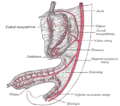- Superior mesenteric artery
-
Artery: Superior mesenteric artery Frontal view of the superior mesenteric artery and its branches. The large vessel (blue) beside the SMA is the superior mesenteric vein. A considerable number of different branching patterns exist. 3D-rendered computed tomography of abdominal aortic branches, showing exit of superior mesenteric artery between the kidneys. Latin arteria mesenterica superior Gray's subject #154 606 Supplies intestine Source abdominal aorta Branches inferior pancreaticoduodenal
middle colic
right colic
intestinal branches (jejunal, ileal)
ileocolicVein superior mesenteric vein Precursor vitelline arteries MeSH Mesenteric+Artery,+Superior In human anatomy, the superior mesenteric artery (SMA) arises from the anterior surface of the abdominal aorta, just inferior to the origin of the celiac trunk, and supplies the intestine from the lower part of the duodenum through two-thirds of the transverse colon, as well as the pancreas.
Contents
Location and path
It arises anterior to vertebra L1 in an adult. It is usually 1cm lower than the celiac trunk. It initially travels in an anterior/inferior direction, passing behind/under the neck of the pancreas and the splenic vein. Located under this portion of the superior mesenteric artery, between it and the aorta, are the following:
- left renal vein - travels between the left kidney and the inferior vena cava (can be compressed by the SMA at this location, leading to Nutcracker Syndrome).
- the third part of the duodenum, a segment of the small intestines (can be compressed by the SMA at this location, leading to Superior Mesenteric Artery Syndrome).
- uncinate process of pancreas - this is a small part of the pancreas that hooks around the SMA.
The SMA typically runs to the left of the similarly named vein, the superior mesenteric vein. After passing the neck of the pancreas it starts giving off its branches.
Branches
Branch Supplies inferior pancreaticoduodenal artery head of the pancreas and to the ascending and inferior parts of the duodenum middle colic artery to the transverse colon right colic artery to ascending colon intestinal arteries branches to ileum, branches to jejunum ileocolic artery (terminal branch of the SMA) supplies last part of ileum, cecum, and appendix The middle, right, and ileocecal branches anastomose with each other to form a marginal artery along the inner border of the colon. This artery is completed by branches of the left colic which is a branch of the inferior mesenteric artery.
Pathophysiology
- Compared to other vessels of similar size, the SMA is largely spared from the effects of atherosclerosis. This may be due to protective haemodynamic conditions.[citation needed]
- Occlusion of the SMA almost invariably leads to intestinal ischemia and often has devastating consequences, with up to 80% of SMA occlusions leading to death.[1]
- The SMA can compress the left renal vein, leading to nutcracker syndrome; and/or the third (horizontal) part of the duodenum, leading to superior mesenteric artery syndrome.
Additional images
References
External links
- SUNY Figs 39:02-01 - "Branches of the inferior mesenteric artery."
- SUNY Labs 40:11-0102 - "Posterior Abdominal Wall: Branches of the Abdominal Aorta"
- SUNY Anatomy Image 8008
- SUNY Anatomy Image 8404
- SUNY Anatomy Image 8815
- SUNY Anatomy Image 8841
- Atlas of anatomy at UMich abdo_wall70 - "Posterior Abdominal Wall, Dissection, Anterior View"
- sup&infmesentericart at The Anatomy Lesson by Wesley Norman (Georgetown University)
List of arteries of torso – abdomen (TA A12.2.12–15, GA 6.598) AA ParietalAnteriorSMAPosteriorvisceralAnteriorvaginal branch ♀V/IVPosteriorsee arteries of lower limbsCategories:- Arteries of the abdomen
Wikimedia Foundation. 2010.










